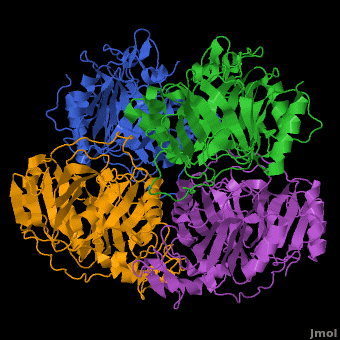Dioxygenase
From Proteopedia
(Difference between revisions)
| Line 7: | Line 7: | ||
* '''Naphthalene 1,2-dioxygenase''' (NDO) catalyzes the conversion of naphthalene and O2 to dihydronaphthalene-diol.<br /> | * '''Naphthalene 1,2-dioxygenase''' (NDO) catalyzes the conversion of naphthalene and O2 to dihydronaphthalene-diol.<br /> | ||
* '''Glyoxalase/bleomycin resistant protein/dioxygenase''' (GBD) catalyzes the cleavage of S-lactoyl-glutathione to methylglyoxal and glutathione. | * '''Glyoxalase/bleomycin resistant protein/dioxygenase''' (GBD) catalyzes the cleavage of S-lactoyl-glutathione to methylglyoxal and glutathione. | ||
| + | |||
| + | === A Hyperactive Cobalt-Substituted Extradiol-Cleaving Catechol Dioxygenase === | ||
| + | <big>Andrew J. Fielding, Elena G. Kovaleva, Erik R. Farquhar, John D. Lipscomb and Lawrence Que</big> <ref>DOI 10.1007/s00775-010-0732-0</ref> | ||
| + | <hr/> | ||
| + | <b>Molecular Tour</b><br> | ||
| + | In most metalloenzyme mechanisms, O<sub>2</sub> is reductively activated by direct electron transfer from the reduced metal ion. This implies that the rate of the reaction should be strongly dependent on the redox potential of the catalytic metal. We have proposed a different strategy for the Fe(II)-containing extradiol aromatic ring-cleaving dioxygenase family in which the activating electron is derived from the aromatic substrate rather the iron. When the aromatic substrate and the O<sub>2</sub> are bound to the metal at the same time, the metal may serve as a conduit for the activating electron. Since there is no net change in metal oxidation state during this process, the impact of the redox potential of the metal on oxygen activation should be minimal, so long as it is low enough to allow formation of the initial O<sub>2</sub> complex. This hypothesis is tested here by substituting Co(II) for Fe(II) in the <scene name='Journal:JBIC:5/Cobalt_overview/1'>Homoprotocatechuate 2,3-dioxygenase</scene> (2,3-HPCD) from ''Brevibacterium fuscum''. | ||
| + | |||
| + | 2,3-HPCD catalyzes the cleavage of the C2-C3 bond of homoprotocatechuate (HPCA) with the incorporation of both oxygen atoms derived from O<sub>2</sub> to form ring opened, 5-carboxymethyl-2-hydroxymuconic semialdehyde (5-CHMSA). Despite the significantly higher standard redox potential of Co(III/II) (1.92 V versus SHE) relative to that of the native metal Fe(II) (0.77 V), Co-HPCD was found to have more than twice the specific activity of Fe-HPCD under saturating O<sub>2</sub> conditions, making Co-HPCD a hyper-active enzyme. The presence of <scene name='Journal:JBIC:5/Cobalt_4_sites/3'>Co in the active sites of Co-HPCD</scene> is illustrated by the 4 strong anomalous difference peaks determined from the X-ray diffraction data set collected at the cobalt K-edge (Figure 4A, 1.6050 Å, 7.725 keV), which shows cobalt coordinated via <scene name='Journal:JBIC:5/Hpcd_active_site/5'>2-His-1-Carboxylate facial triad</scene>. The structural comparison of the high-resolution X-ray crystal structures of Fe-HPCD (1.70 Å, [[3ojt]]), Mn-HPCD (1.65 Å, [[3ojn]]), and Co-HCPD (1.72 Å, [[3ojj]]) shows <scene name='Journal:JBIC:5/Overlays/16'>no significant structural differences in the active site</scene> environment as indicated by the RMSD values of 0.10-0.14 Å for superposition of <scene name='Journal:JBIC:5/Overlays_15a/10'>all atoms within 15 angstroms of the metal center</scene>. In addition, the presence of Co in the active site of HPCD has <scene name='Journal:JBIC:5/Substrate_intro/6'>no structural consequences</scene> on either the <scene name='Journal:JBIC:5/Substrate_overlay/15'>mode of substrate binding</scene> or on the conformational integrity of the active site residues in<scene name='Journal:JBIC:5/Substrate_overlay/16'> the 1st or 2nd coordination sphere environment</scene>. The absence of any observable structural differences upon metal substitutions suggests that differential redox tuning of the metal centers in this dioxygenase is highly unlikely. Rather, the 2,3-HPCD enzyme can carry out the O<sub>2</sub> activation and oxidative ring-cleavage efficiently over a large range of metal redox potentials. The structural analysis supports the proposed mechanism described above in which the ability of the enzyme to activate molecular O<sub>2</sub> does not correlate with redox potential of the metal center. However, the current results also show that the rates of individual steps in the overall catalytic cycle can be effected by the metal present in the active site of HPCD, resulting in a earlier rate-limiting step for Co-HPCD compared to Fe-HPCD and Mn-HPCD. | ||
</StructureSection> | </StructureSection> | ||
Revision as of 10:55, 7 May 2015
| |||||||||||
3D structures of Protocatechuate 3,4-dioxygenase
Updated on 07-May-2015
Proteopedia Page Contributors and Editors (what is this?)
Michal Harel, Alexander Berchansky, Joel L. Sussman, Jaime Prilusky

